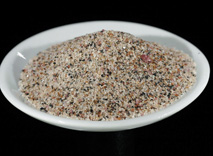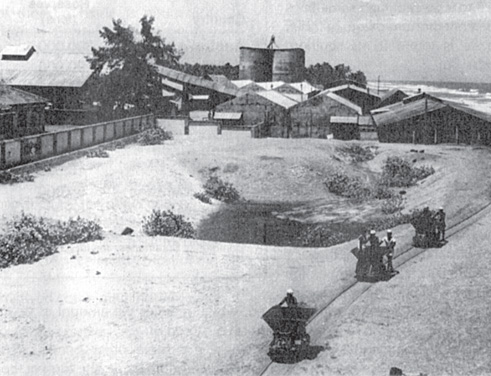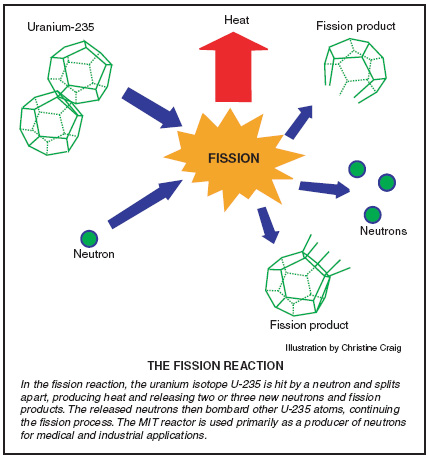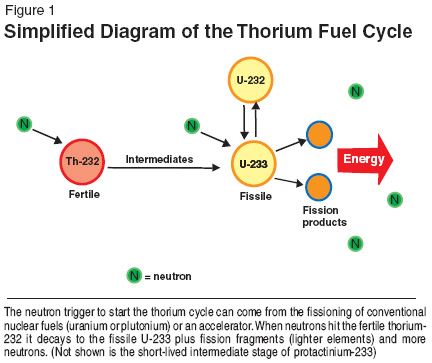Nuclear engineer Ramtanu Maitra explains how the
development of thorium fuel cycles will enhance the efficiency and economy of
nuclear power plants. This article is excerpted from the Fall 2005 issue
of 21st Century Science & Technology magazine. Australia has the world’s
largest extractable reserves of thorium, so it would be crazy for us not to be
world leaders in developing thorium-fuelled reactors.
 Thorium is an abundant element
in nature with multiple advantages
as a nuclear fuel for future
reactors of all types. Thorium ore,
or monazite, exists in vast amounts
in the dark beach sand of India,
Australia, and Brazil. It is also
found in large amounts in Norway,
the United States, Canada, and
South Africa. Thorium-based fuel
cycles have been studied for about
30 years, but on a much smaller
scale than uranium or uranium/plutonium
cycles. Germany, India, Japan,
Russia, the United Kingdom,
and the United States have conducted
research and development,
including irradiating thorium fuel
in test reactors to high burn-ups.
Several reactors have used thorium-based fuel.
Thorium is an abundant element
in nature with multiple advantages
as a nuclear fuel for future
reactors of all types. Thorium ore,
or monazite, exists in vast amounts
in the dark beach sand of India,
Australia, and Brazil. It is also
found in large amounts in Norway,
the United States, Canada, and
South Africa. Thorium-based fuel
cycles have been studied for about
30 years, but on a much smaller
scale than uranium or uranium/plutonium
cycles. Germany, India, Japan,
Russia, the United Kingdom,
and the United States have conducted
research and development,
including irradiating thorium fuel
in test reactors to high burn-ups.
Several reactors have used thorium-based fuel.
India is by far the nation most
committed to study and use of thorium
fuel; no other country has
done as much neutron physics
work on thorium as have Indian
nuclear scientists. The positive results
obtained in this neutron physics
work have motivated the Indian
nuclear engineers to use thorium-
based fuels in their current
plans for the more advanced reactors
that are now under construction.
 India decided on a three-stage
nuclear program back in the 1950s,
when its nuclear power generation
program was set up. In the first
stage, natural uranium (U-238) was
used in pressurized heavy water
reactors (PHWRs), of which there
are now 12. In the second stage,
the plutonium extracted from the
spent fuel of the PHWRs was scheduled
to be used to run fast breeder
reactors. The fast breeders would
burn a 70-percent mixed oxide
(MOX) fuel to breed fissile uranium-
233 (U-233) in a thorium-232
(Th-232) blanket around the core.
In the final stage, the fast breeders
would use Th-232 and produce U-
233 for use in new reactors. One
main advantage of using a combination
of thorium and uranium is
related to the proliferation question:
There is a significant reduction
in the plutonium content of
the spent fuel, compared with what
comes out of a conventional uranium-
fueled reactor. Just how
much less plutonium is made? The
answer depends on exactly how the
uranium and thorium are combined.
For example, uranium and
thorium can be mixed homogeneously
within each fuel rod, and in
this case the amount of plutonium
produced is roughly halved. But
mixing them uniformly is not the
only way to combine the two elements,
and the mix determines the
plutonium production.
India decided on a three-stage
nuclear program back in the 1950s,
when its nuclear power generation
program was set up. In the first
stage, natural uranium (U-238) was
used in pressurized heavy water
reactors (PHWRs), of which there
are now 12. In the second stage,
the plutonium extracted from the
spent fuel of the PHWRs was scheduled
to be used to run fast breeder
reactors. The fast breeders would
burn a 70-percent mixed oxide
(MOX) fuel to breed fissile uranium-
233 (U-233) in a thorium-232
(Th-232) blanket around the core.
In the final stage, the fast breeders
would use Th-232 and produce U-
233 for use in new reactors. One
main advantage of using a combination
of thorium and uranium is
related to the proliferation question:
There is a significant reduction
in the plutonium content of
the spent fuel, compared with what
comes out of a conventional uranium-
fueled reactor. Just how
much less plutonium is made? The
answer depends on exactly how the
uranium and thorium are combined.
For example, uranium and
thorium can be mixed homogeneously
within each fuel rod, and in
this case the amount of plutonium
produced is roughly halved. But
mixing them uniformly is not the
only way to combine the two elements,
and the mix determines the
plutonium production.

India has completed the first
phase of its program, and moved
into the second phase with a small
experimental fast breeder reactor,
and, in 2004, began the construction
of a 300 MW Advanced Heavy
Water Reactor (AWHR), as a prototype
for the third phase. The innovative
design of the AHWR is
characterized by extensive passive
safety features, making it very safe.

Abundance of Thorium
The thorium fuel cycle has many
attractive features. To begin with,
thorium is much more abundant in
nature than uranium. Soil commonly
contains an average of
around six parts per million (ppm)
of thorium, three times as much as
uranium. Thorium occurs in several
minerals, the most common being
the rare earth thorium-phosphate
mineral, monazite, which
usually contains from 3 to 9 percent,
and sometimes up to 12 percent
thorium oxide. In India, the
monazite is found in its southern
beach sands.

Th-232 decays very slowly (its
half-life is about three times the
age of the Earth). Most other thorium
isotopes are short-lived and
thus much more radioactive than
Th-232, but of negligible quantity.
In addition to thorium’s abundance,
all of the mined thorium is
potentially usable in a reactor,
compared with only 0.7 percent of
natural uranium. In other words,
thorium has some 40 times the
amount of energy per unit mass
that could be made available, compared
with uranium.
From the technological angle,
one reason that thorium is preferred
over enriched uranium is
that the breeding of U-233 from
thorium is more efficient than the
breeding of plutonium from U-238.
This is so because the thorium fuel
creates fewer non-fissile isotopes.
Fuel-cycle designers can take advantage
of this efficiency to decrease
the amount of spent fuel per
unit of energy generated, which
reduces the amount of waste to be
disposed of.
There are some other benefits.
For example, thorium oxide, the
form of thorium used for nuclear
power, is a highly stable compound—
more so than the uranium
dioxide that is usually employed
in today’s conventional nuclear
fuel. Also, the thermal conductivity
of thorium oxide is 10 to 15 percent
higher than that of uranium
dioxide, making it easier for heat
to flow out of the fuel rods used
inside a reactor.
In addition, the melting point of
thorium oxide is about 500 degrees
Celsius higher than that of
uranium dioxide, which gives the
reactor an additional safety margin,
if there is a temporary loss of
coolant.
The one challenge in using thorium
as a fuel is that it requires neutrons
to start off its fission process.
These neutrons can be provided by
the conventional fissioning of uranium
or plutonium fuel mixed into
the thorium, or by a particle accelerator.
Most of the past thorium
research has involved combining
thorium with conventional nuclear
fuels to provide the neutrons to
trigger the fission process.
The approach undergoing the
most investigation now is a combination
that keeps a uranium-rich
“seed” in the core, separate from a
thorium-rich “blanket.” The chief
proponent of this concept was the
late Alvin Radkowsky, a nuclear
pioneer who, under the direction
of Admiral Hyman Rickover,
helped to launch America’s Nuclear
Navy during the 1950s, when
he was chief scientist of the U.S.
Naval Reactors Program. Radkowsky,
who died in 2002 at age
86, headed up the design team that
built the first U.S. civilian nuclear
reactor at Shippingport, Pennsylvania,
and made significant contributions
to the commercial nuclear
industry during the 1960s
and 1970s.
Although thorium is not fissile
like U-235, Th-232 absorbs slow
neutrons to produce U-233, which
is fissile. In other words, Th-232 is
fertile, like U-238. The Th-232
absorbs a neutron to become Th-
233, which decays to protactinium-
233 (Pa-233) and then to fissionable
U-233. When the irradiated fuel
is unloaded from the reactor, the
U-233 can be separated from the
thorium, and then used as fuel in
another nuclear reactor. Uranium-
233 is superior to the conventional
nuclear fuels, U-235 and Pu-239,
because it has a higher neutron
yield per neutron absorbed. This
means that once it is activated by
neutrons from fissile U-235 or Pu-
239, thorium’s breeding cycle is
more efficient than that using U-
238 and plutonium.

The Russian-U.S. Program
Since the early 1990s, Russia
has had a program based at Moscow’s Kurchatov Institute to develop
a thorium-uranium fuel. The
Russian program involves the U.S.
company Thorium Power, Inc.
(founded by Radkowsky), which
has U.S. government and private
funding to design fuel for the conventional
Russian VVER-1000 reactors.
Unlike the usual nuclear
fuel, which uses enriched uranium
oxide, the new fuel assembly design
has the plutonium in the center
as the “seed,” in a demountable
arrangement, with the thorium and
uranium around it as a “blanket.” ...
One study concludes:
“Thorium fuel offers a promising
means to dispose of excess
weapons-grade plutonium in Russian
VVER-1000 reactors. Using
the thorium fuel technology, plutonium
can be disposed of up to
three times as fast as MOX at a significantly
lower cost. Spent thorium
fuel would be more proliferation-
resistant than spent MOX
(mixed oxide) fuel. ... [The thorium
fuel technology] will not require
significant and costly reactor
modifications. Thorium fuel
also offers additional benefits in
terms of reduced weight and volume
of spent fuel and therefore
lower disposal costs.”
Thorium Fuel Operating
Experience
There have been four decades
of research and development on
thorium fuel cycles, including in
the ultra-safe pebble-bed modular
reactor (PBMR) now being built
in South Africa and China.
Between 1967 and 1988, the
AVR (Arbeitsgemeinschaft Versuchsreaktor
– “working group test
reactor”) experimental pebble bed
reactor at Jülich, Germany (the basis
for the South African and Chinese
PBMRs), operated for more
than 750 weeks at 15 megawatts-electric,
about 95 percent of the
time with thorium-based fuel. The
fuel used consisted of about
100,000 billiard ball-size fuel elements.
Overall, a total of 1,360 kilograms
of thorium was used, mixed
with highly enriched uranium
(HEU). Maximum burn-ups of
150,000 megawatt-days were
achieved. Thorium fuel elements
with a 10:1 ratio of thorium to
highly enriched uranium were irradiated
in the 20-megawatts-thermal
(MWt) Dragon reactor at Winfrith,
United Kingdom, for 741 full-power
days. Dragon was run as a
cooperative project of the Organization
of Economic Cooperation
and Development and Euratom,
involving Austria, Denmark, Sweden,
Norway, and Switzerland, in
addition to the United Kingdom,
from 1964 to 1973. The thorium-uranium
fuel was used to “breed
and feed,’’ so that the U-233 that
was formed, replaced the U-235 at
about the same rate, and fuel could
be left in the reactor for about six
years. The General Atomics Peach
Bottom high-temperature, graphite-
moderated, helium-cooled reactor
(HTGR) in the United States
operated between 1967 and 1974
at 110-MWt, using highly enriched
uranium with thorium.
In India, the Kamini 30-kWt experimental
neutron-source research
reactor started up in 1996 near
Kalpakkam, using U-233 which
was recovered from thorium-dioxide
fuel that had been irradiated in
another reactor. The Kamini reactor
is adjacent to the 40-MWt Fast
Breeder Test Reactor, in which the
thorium-dioxide is irradiated.
In the Netherlands, an aqueous
homogenous suspension reactor
has operated at 1 megawatt-thermal
for three years. The highly enriched
uranium/thorium fuel is circulated
in solution, and reprocessing
occurs continuously to remove
fission products, resulting in a high
conversion rate to U-233.
Thorium in Power Reactors
The 300-MWe Thorium High-
Temperature Reactor (THTR) in
Germany was developed from the
Jülich, Germany AVR noted above,
and operated between 1983 and
1989 with 674,000 pebbles, over
half of them containing thorium/
highly enriched uranium fuel (the
rest of the pebbles were graphite
moderator and some neutron absorbers). These pebbles were continuously
recycled on load, and on
average the fuel passed six times
through the core. Fuel fabrication
was on an industrial scale.
The Fort St. Vrain reactor in
Colorado was the only commercial
thorium-fueled nuclear plant in the
United States. Also developed
from the AVR in Germany, it operated
from 1976 to 1989. It was a
high-temperature (700EC), graphite-
moderated, helium-cooled reactor
with a thorium/highly enriched
uranium fuel, which was
designed to operate at 842 megawatts-
thermal (330 MWe). The fuel
was contained in microspheres of
thorium carbide and Th/U-235 carbide,
coated with silicon oxide and
pyrolytic carbon to retain fission
products.
Unlike the pebble bed design,
the fuel was arranged in hexagonal
columns (“prisms”) in an annular
configuration. Almost 25
tons of thorium were used in the
reactor fuel, achieving a 170,000-
megawatt-days burn-up.
Thorium-based fuel for Pressurized
Water Reactors (PWRs) was
investigated at the Shippingport
reactor in the United States (the first
U.S. commercial reactor, started up
in 1957), using both U-235 and
plutonium as the initial fissile material.
The light water breeder reactor
(LWBR) concept was also
successfully tested at Shippingport,
from 1977 to 1982, with thorium
and U-233 fuel clad with zircaloy,
using the “seed/blanket”
concept.
Another reactor type, the 60- MWe Lingen Boiling Water Reactor
(BWR) in Germany also utilized
fuel test elements that were
thorium-plutonium based.



Proliferation Issues
In the early days of the civilian
nuclear program, the Acheson-Lilienthal
Report in 1946 warned of
the connection between civilian
nuclear power and nuclear weapons,
and concluded that the world
could not rely on safeguards alone
“to protect complying states
against the hazards of violations
and evasions”—illicit nuclear
weapons. Acheson-Lilienthal proposed
international controls over
nuclear power, but also considered
possible technical innovations
that would make it harder to divert
nuclear materials into bomb-making.
The thorium fuel cycle is
one such technical innovation—as yet untapped.
A 1998 paper by Radkowsky
and Galparin describes the most
advanced work in developing a
practical nuclear power system that
could be made more “proliferation
resistant” than conventional reactors
and fuel cycles. Based on a
thorium fuel cycle, it has the potential
to reduce the amount of plutonium
generated per gigawatt-year
by a factor of five, compared
to conventional uranium-fueled
reactors. It would also make the
generated plutonium and uranium-
233 much more difficult to use
for producing bomb material.
Heightened current concerns
about preventing the spread of
bomb-making materials, have led
to an increase in interest in developing
thorium-based fuels. The
U.S. Department of Energy has
funded Radkowsky’s company
(Thorium Power) and its partners
in their tests with Russian reactors,
as well as three other efforts (two
national laboratories, two fuel fabrication
companies, and a consortium
of three universities). This
research is geared to designing a
thorium fuel system that will fit
with conventional reactors. There
is also a new company, Novastar
Resources, that is buying up thorium
mines in anticipation of thorium-fueled reactors in the future.
The proliferation potential of the
light water reactor fuel cycle may
be significantly reduced by using
thorium as a fertile component of
the nuclear fuel, as noted above.
The main challenge of thorium utilization
is to design a core and a
fuel cycle that would be proliferation-
resistant and economically
feasible. This challenge is met by
the Radkowsky Thorium Reactor
concept. So far, the concept has
been applied to a Russian design
of a 1,000-MW pressurized water
reactor VVER, designated as
VVERT.
The main results of the
preliminary reference design are as
follows: The amount of plutonium
contained in the Radkowsky
Thorium Reactor spent fuel stockpile
is reduced by 80 percent, in
comparison with a VVER of conventional
design. The isotopic
composition of the reactor’s plutonium
greatly increases the probability
of pre-initiation and yield
degradation of a nuclear explosion.
An extremely large Pu-238
content causes correspondingly
large heat emission, which would
complicate the design of an explosive
device based on plutonium
from this reactor.
The economic incentive to reprocess
and reuse the fissile component
of the Radkowsky Thorium
Reactor spent fuel is also decreased.
The once-through cycle
is economically optimal for its
core and cycle.
To reiterate the proliferation difficulties:
the replacement of a
standard (uranium-based) fuel for
nuclear reactors of current generation
by the Radkowsky Thorium
Reactor fuel will provide a strong
barrier for nuclear weapon proliferation.
This barrier, in combination
with existing safeguard measures
and procedures, is adequate
to unambiguously disassociate civilian
nuclear power from military
nuclear power.
Other scientists point out that
even if a terrorist group wanted to
use the blanket plutonium for
making a bomb, the process of extracting
it from thorium fuel would
be more difficult than removing it
from conventional spent fuel. This
is because the spent blanket fuel
from a thorium fuel cycle would
contain uranium-232, which over
time decays into isotopes that emit
high-energy gamma rays. To extract
the plutonium from this spent
fuel would require significantly
more radiation shielding plus additional
remotely operated equipment
in order to reprocess it for
weapons use, making a daunting
task even more difficult. It would
also be more complicated to separate
the fissionable U-233 from uranium-
238, because of the highly
radioactive products present.
Overall, the development of thorium
fuel cycles makes sense for the
future, for advancing the efficiency
and economy of nuclear power
plants, ease of recycling, and making
it more difficult to divert radioactive
materials for weapons.
Continue to Hot Air Over Wind Energy
Return to Nuclear and Thorium Power